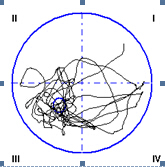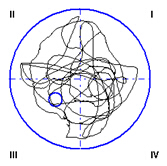Explore the Morris water maze test indicators / evaluation indicators
Although there are many complicated evaluation indicators mentioned in the literature, they are not well characterized and standardized. For example, swimming speed is obviously an indicator of exercise capacity, and path length is affected by both swimming speed and swimming time (latency). In theory, it should not be a good indicator for judging cognitive ability. Therefore, the nature of the behavior reflected in the indicators needs to be explored, and caution should be exercised when interpreting these indicators. The use of latency alone as an indicator does not provide enough information about spatial learning, because swimming fast does not mean that learning efficiency is high and memory is good.
Parameter definition criteria:
1. The total distance (total activity) is the total movement distance of the experimental animals: it is directly related to the swimming speed of the animals themselves. In the same time, it only reflects the speed of the swimming speed of the animals; that is, the longer the distance, the animal's The faster you swim.
2. Total time : The total observation time from the start of recording to the end of recording, which is a single training time, generally 60s.
3. Average speed : total distance / total time, from which we can see the individual difference of animal swimming speed, the animal's incubation period and swimming speed have a certain relationship;
4. Time of attendance (latency period) : refers to the time required for the first successful completion of the platform after the experimental animals enter the water; successful stage means that the stay on the stage is more than 5 to 10 seconds (can be defined by themselves), if the stay time Less than 5 to 10 seconds, it is not counted, and the incubation period is the training time;
The incubation period is a very important reference indicator for the morris water maze. Its length of time also represents the ability of animal space to learn and remember. The incubation period is short, indicating that the animal's learning and memory ability is good; but it is related to the animal's own swimming speed, such as Some normal rats swim faster, so the incubation period is longer than that of the dementia group. In addition, some animals will watch the circle when they are placed in the water, or they can swim directly to the stage after standing in the same direction. This phenomenon indicates that the animal has good memory. This phenomenon is very important. If the situation is found in the treatment group, it is very good. However, because the animal does not move in place, the incubation period may be long at this time, so the incubation period cannot be used as the final indicator for judging the memory.
5. Before the stage : refers to the distance that the experimental animals exercise before the first successful stage; related to the incubation period, the longer the incubation period, the greater the distance before going on stage; the two are in a positive relationship. Therefore, it also indirectly reflects the length of the incubation period, and can also be regarded as one of the indicators for assessing the memory of animals.
6. Average speed before going to the stage : the time before going to the stage / the time of going on stage; from which we can see the individual difference of the swimming speed of the animal, the incubation period of the animal has a certain relationship with the swimming speed;
7. Quadrant Activity Index
First quadrant activity path: the sum of the distances of the experimental animals in the first quadrant;
First quadrant activity time: the sum of the time of the experimental animal in the first quadrant;
Second quadrant activity path: the sum of the distances of the experimental animals in the second quadrant;
Second quadrant activity time: the sum of time of the experimental animals in the second quadrant;
Third quadrant activity path: the sum of the distances of the experimental animals in the third quadrant;
Since the platform is generally placed in the third quadrant, the longer the distance in this quadrant activity, the better the spatial memory ability of the animal is reflected;
Third quadrant activity time: the sum of time of the experimental animals in the third quadrant;
Since the platform is generally placed in the third quadrant, the longer the activity in this quadrant, the better the spatial memory ability of the animal;
Fourth quadrant activity path: the sum of the distances of the experimental animals in the fourth quadrant;
Fourth quadrant activity time: the sum of the time of the experimental animal in the fourth quadrant;
Center activity distance: the sum of the distances of experimental animals in the central area of ​​the pool;
Rodent swimming has edging and marginality, while the platform is close to the center of the pool. If the animal changes the swimming route and travels in the center of the pool for a long time, it reflects its spatial memory ability.
Central activity time: the sum of the time of the experimental animals in the central area of ​​the pool;
Rodent swimming has edging and marginality, while the platform is close to the center of the pool. If the animal changes the swimming route for a long time in the central area of ​​the pool, it reflects its spatial memory ability.
Surrounding activity: the sum of the distances of experimental animals in the area surrounding the pool;
Rodent swimming has edging and marginality, while the platform is close to the center of the pool. If the animal has a long distance in the surrounding area of ​​the pool, it reflects its poor spatial memory.
Activity time around: the sum of the time of the experimental animals in the area surrounding the pool;
Rodent swimming has edging and marginality, while the platform is close to the center of the pool. If the animal is active in the surrounding area of ​​the pool for a long time, it reflects its poor spatial memory.
Range I activity distance around the platform: the sum of the distances of the experimental animals in the area around the station I;
Scope around the platform I Activity time: the sum of the time of the experimental animals in the area around the platform I;
Range II activity distance around the platform: the sum of the distances of the experimental animals in the area surrounding the platform II;
Range II activity time around the platform: the sum of the time of the experimental animals in the area surrounding the platform II;
Range III activity distance around the platform: the sum of the distances of the experimental animals in the area around the platform III;
Range III activity time around the platform: the sum of the time of the experimental animals in the area around the platform III;
Range IV activity distance around the platform: the sum of the distances of the experimental animals in the area surrounding the station IV;
Range IV activity time around the platform: the sum of the time of the experimental animals in the area surrounding the station IV;
The longer the distance and time of activity around the platform, the better the spatial memory of the animal .
Number of station crossings: refers to the number of times the experimental animals pass through the original station position within a certain period of time after the platform is removed. (Through one point in and out of the station area once);
In a certain period of time, the more times the animal passes through the original station position, the better the space learning and memory ability.
Initial angle (radian): refers to the angle between the tangent of the starting point of the animal's motion trajectory and the line connecting the starting point and the center of the platform after the experimental animal is placed in the pool;
If the angle of the initial angle is smaller, the animal remembers the position of the platform and swims directly to the platform to reflect the spatial learning and memory ability.
Into the water quadrant: the quadrant in which the experimental animal enters the water;
8. Search strategy:
(1) Straight line: the connecting line between the experimental animal's water inlet point and the platform center is the central axis. If the distance between all the animal's motion trajectories and the central axis does not exceed 15% of the radius, and the movement time in the area is at least the total movement. 70% of the time is considered to be a linear strategy for experimental animals.
(2) Tendency: similar to the linear type, the experimental animal inlet point is connected to the center of the platform as the central axis. If the distance between all the movement trajectories of the animal and the central axis does not exceed 50% of the radius, and the motion is in the area. At least 70% of the total exercise time is considered to be a trend-oriented strategy for experimental animals.
(3) Edge type: Take the center of the experimental animal movement area as the center, take the radius of 75% to make a circle. If more than 70% of the animals are active outside the circle, the experimental animal's movement is considered to be a marginal strategy.
(4) Random type: If the experimental animal's exercise strategy is different from the above three, the experimental animal's movement is considered to be a randomized strategy.
Search strategy and tactility are two indicators for measuring the ability of animals to analyze and judge problems and solve problems. The way rats look for platforms can be roughly divided into four types: edge type, random type, trend type and straight line type. Different search methods represent the search platform for rats with different strategies. The search strategy of normal animals shows the change pattern of “edge → random → trend → linear†with the increase of training times. The search strategy of dementia animals will change abnormally. For example, only marginal → random, or random → edge, trend and linear are relatively rare.



Straight line trend type edge type
Medical Cold Patch
Patch for diarrhea
[Name] Medical Cold Patch
[Package Dimension] 5cm 4pieces/box
The pain relief patch is composed of three layers, namely, backing lining, middle gel and protective film. It is free from pharmacological, immunological or metabolic ingredients.
[Scope of Application] For cold physiotherapy, closed soft tissue only.
[Indications]
The patches give a fast relief for diarrhea.
[How To Use a Patch]
Please follow the Schematic Diagram. One piece, one time.
The curing effect of each piece can last for 6-8 hours.
[Attention]
Do not apply the patch on the problematic skin, such as wounds, eczema, dermatitis,or in the eyes. People allergic to herbs and the pregnant are advised not to use the medication. If swelling or irritation occurs, please stop using and if any of these effects persist or worsen.notify your doctor or pharmacist promptly. Children using the patch must be supervised by adults.
[Storage Conditions]
Store below 30c in a dry place away from heat and direct sunlight.
Patch For Diarrhea,Medicated Patches For Arthiritis,Plaster For Diarrhea,Pad For Diarrhea
Shandong XiJieYiTong International Trade Co.,Ltd. , https://www.xjpatches.com